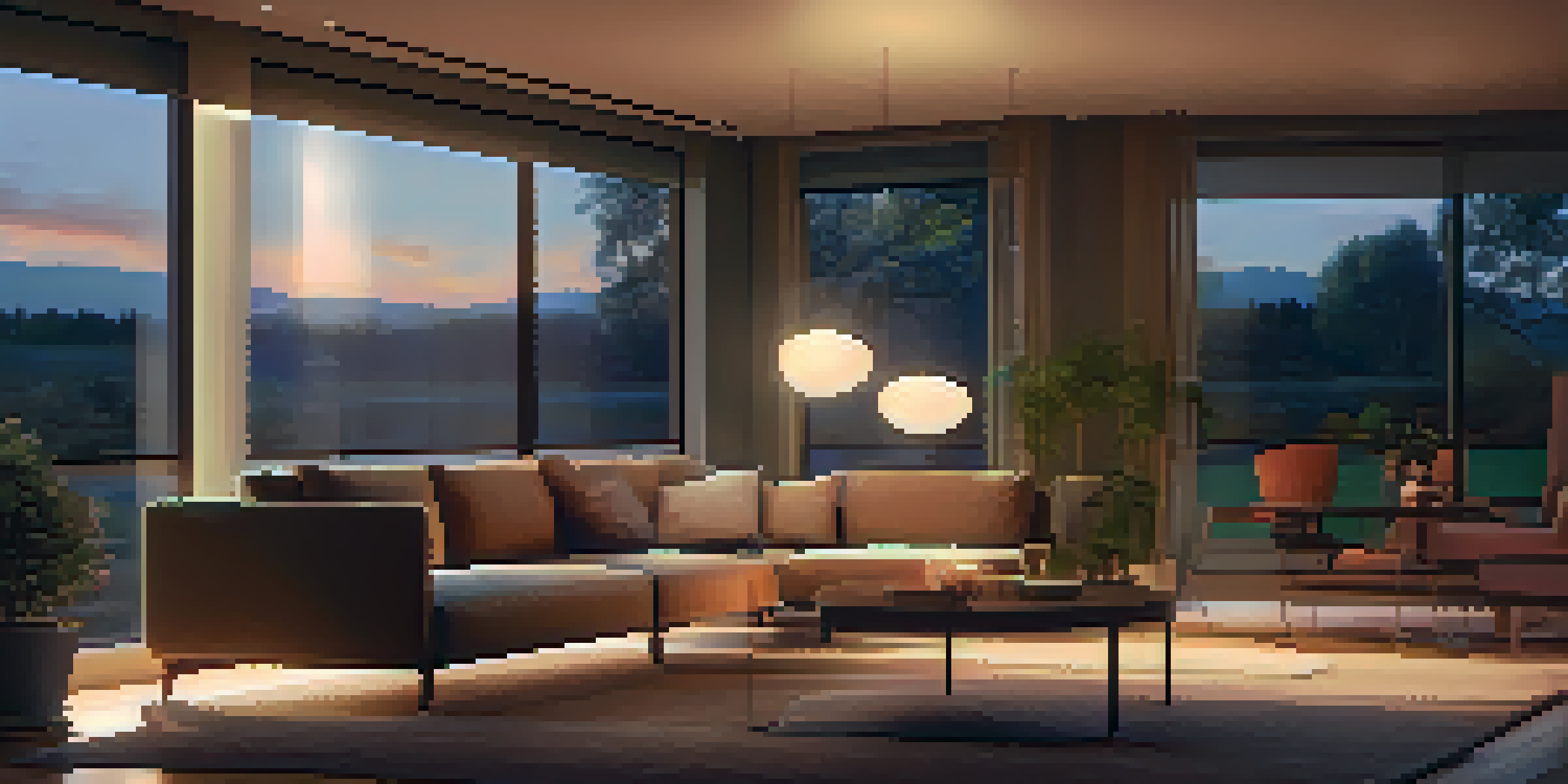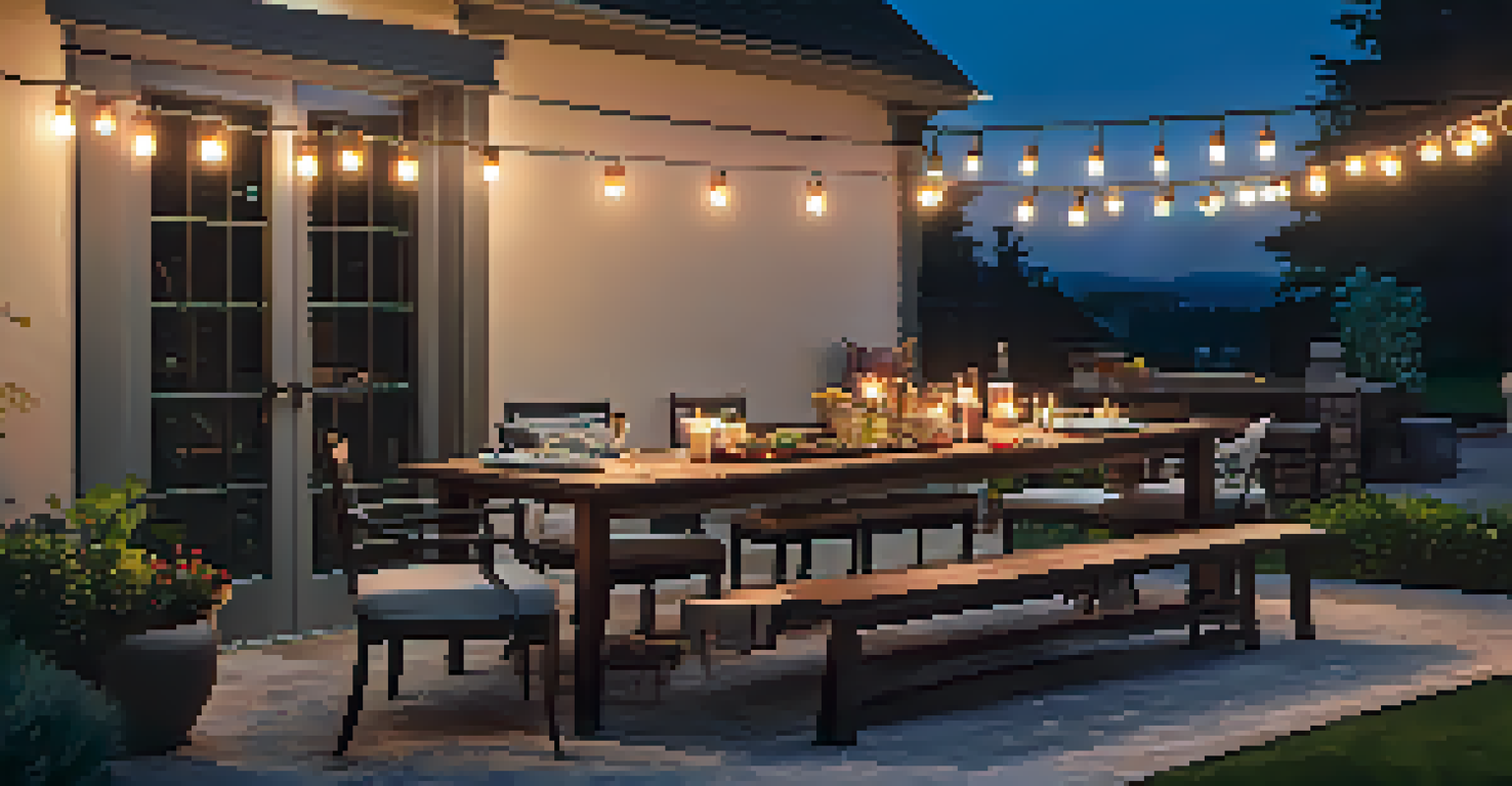Integrating Lighting with Smart Home Devices for Convenience

Understanding Smart Home Lighting Integration
Smart home lighting refers to the use of advanced technologies to control your home’s lighting system. This integration allows homeowners to manage lights remotely through apps or voice commands, adding a level of convenience that traditional lighting lacks. Imagine being able to dim the lights from your couch or set a schedule for your lights to turn on automatically when the sun sets.
The future is already here – it's just not very evenly distributed.
The essence of smart lighting is not just about convenience; it's about creating an atmosphere that enhances your daily life. For instance, you can set different light moods for various activities—bright lights for reading, soft hues for relaxation, or colorful settings for parties. This flexibility can significantly improve how you experience your home.
Furthermore, integrating lighting with other smart devices, like thermostats and security systems, creates a seamless living environment. When you leave home, your smart lighting can automatically turn off while ensuring your security cameras are activated. This interconnectedness not only makes life easier but also enhances safety.
Benefits of Smart Lighting in Your Home
The benefits of smart lighting extend beyond mere convenience. Energy efficiency is a significant advantage; smart bulbs can reduce energy consumption by adjusting brightness based on the time of day or occupancy. This means lower electricity bills and a smaller carbon footprint, which is great for both your wallet and the planet.

Additionally, smart lighting can enhance home security. With features like scheduling and remote access, you can make it appear as if someone is home, even when you're away. For example, you could program your lights to turn on at dusk and off at dawn, deterring potential intruders.
Smart Lighting Enhances Convenience
Smart lighting allows homeowners to control their lights remotely, creating a convenient and flexible living environment.
Health and wellness also play a role in the benefits of smart lighting. Certain smart bulbs mimic natural sunlight, which can help regulate your circadian rhythm. By using these lights in the morning, you could boost your mood and energy levels, creating a more vibrant and focused day.
How to Choose the Right Smart Lighting
Choosing the right smart lighting can feel overwhelming with so many options available. Start by considering your needs—do you want to control your lights with your smartphone, or would you prefer voice control through a virtual assistant? Understanding your preferences helps narrow down the choices and makes the decision process smoother.
Technology is best when it brings people together.
Next, think about compatibility with your existing smart home ecosystem. If you already have devices like smart speakers or hubs, ensure the lighting system you choose integrates seamlessly with them. This ensures a cohesive experience, allowing you to control all devices from a single app or voice command.
Lastly, consider the aesthetics and functionality of the smart bulbs. Look for options that offer adjustable brightness, color changes, and styles that fit your home décor. After all, while technology is crucial, the right lighting should also contribute to the overall ambiance of your space.
Setting Up Your Smart Lighting System
Setting up a smart lighting system can be a straightforward process if you follow the right steps. Start by selecting a compatible hub or smart assistant that will serve as the central control point for your lights. Many brands offer user-friendly apps that guide you through the installation process, making it accessible for everyone.
Once you have your hub, install the smart bulbs in your desired fixtures. Most smart bulbs can be installed just like traditional bulbs, but make sure to follow any specific instructions provided by the manufacturer. After installation, connect the bulbs to your hub via the app, allowing you to control them with ease.
Energy Efficiency and Security Boost
Smart lighting systems can reduce energy consumption and enhance home security through features like scheduling and remote access.
Finally, customize your settings according to your lifestyle. You can set schedules for when lights turn on and off, create specific scenes for different activities, or even set up routines that trigger multiple devices at once. For example, a 'Good Night' routine could turn off all lights and lower the thermostat, making bedtime a breeze.
Integrating Smart Lighting with Other Devices
One of the most exciting aspects of smart lighting is its ability to integrate with other smart home devices. For instance, pairing your smart lights with a smart thermostat allows you to adjust the lighting and temperature simultaneously for maximum comfort. Imagine walking into a room where the lights brighten and the thermostat adjusts as you enter—pure magic!
Additionally, smart lighting can enhance your home security system. You can set your lights to flash if an alarm is triggered, drawing attention to the situation. This integration not only provides peace of mind but also acts as a visual deterrent for potential intruders.
Moreover, connecting smart lighting to entertainment systems elevates your movie-watching experience. Sync your lights with the action on the screen, allowing them to change colors or dim in response to the film’s mood. This immersive experience makes movie nights more enjoyable for family and friends alike.
Common Challenges and Solutions
While integrating smart lighting into your home can be rewarding, there are some common challenges that users might face. One issue is connectivity; if your Wi-Fi signal is weak, it can lead to delays or disconnections. To address this, consider investing in a Wi-Fi extender or directly connecting your smart devices to a hub for a more stable connection.
Another challenge is the potential for compatibility issues between different brands. Not all smart devices work seamlessly together, which can lead to frustration. To avoid this, do your research and choose products that are known for their interoperability, or stick to devices from the same brand for a smoother integration.
Future Innovations in Smart Lighting
Advancements in technology promise to make smart lighting even more intuitive and energy-efficient, adapting to users' habits and preferences.
Lastly, users may find the initial setup process daunting. To make it easier, follow step-by-step guides provided by the manufacturers, and don’t hesitate to seek help from online communities or customer service. With a little patience, you’ll soon be enjoying the benefits of your new smart lighting system.
The Future of Smart Lighting Technology
The future of smart lighting technology is bright, with innovations continuously emerging to enhance convenience and efficiency. As smart home ecosystems evolve, we can expect to see even greater integration between lighting and other home systems. For instance, future smart lights may use sensors to automatically adjust brightness based on natural light levels, making your home even more energy-efficient.
Additionally, advancements in artificial intelligence (AI) promise to create smarter lighting systems that learn your habits and preferences over time. Imagine a lighting system that anticipates your needs, adjusting automatically as you move from room to room or react to changes in your schedule.

As smart lighting becomes more accessible and affordable, it’s likely that we will see a surge in adoption among homeowners. This shift not only enhances convenience but also contributes to a more sustainable lifestyle, as smarter lighting can play a significant role in reducing energy consumption. The future of smart lighting is not just about convenience; it’s about creating a more intelligent and responsive living environment for everyone.